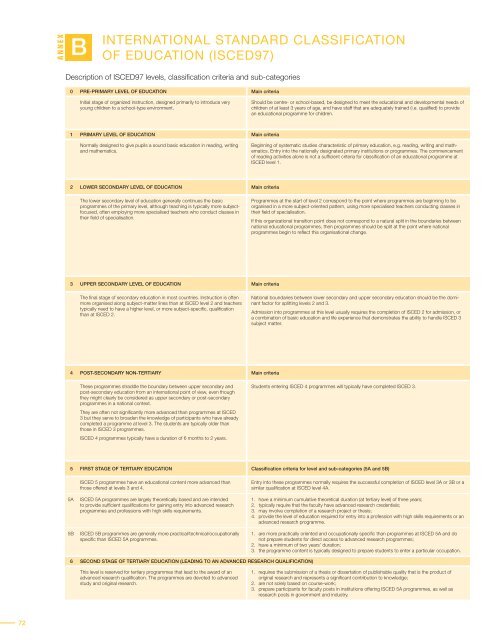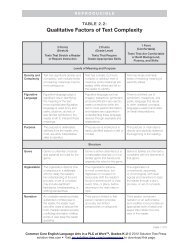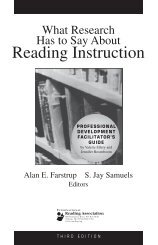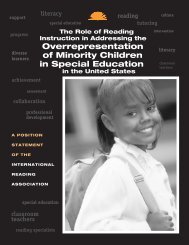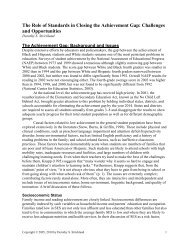Global Education Digest 2012 - International Reading Association
Global Education Digest 2012 - International Reading Association
Global Education Digest 2012 - International Reading Association
You also want an ePaper? Increase the reach of your titles
YUMPU automatically turns print PDFs into web optimized ePapers that Google loves.
A N N E X<br />
B<br />
INTERNATIONAL STANDARD CLASSIFICATION<br />
OF EDUCATION (ISCED97)<br />
Description of ISCED97 levels, classification criteria and sub-categories<br />
0 PRE-PRIMARY LEVEL OF EDUCATION Main criteria<br />
Initial stage of organized instruction, designed primarily to introduce very<br />
young children to a school-type environment.<br />
Should be centre- or school-based, be designed to meet the educational and developmental needs of<br />
children of at least 3 years of age, and have staff that are adequately trained (i.e. qualified) to provide<br />
an educational programme for children.<br />
1 PRIMARY LEVEL OF EDUCATION Main criteria<br />
Normally designed to give pupils a sound basic education in reading, writing<br />
and mathematics.<br />
Beginning of systematic studies characteristic of primary education, e.g. reading, writing and mathematics.<br />
Entry into the nationally designated primary institutions or programmes. The commencement<br />
of reading activities alone is not a sufficient criteria for classification of an educational programme at<br />
ISCED level 1.<br />
2 LOWER SECONDARY LEVEL OF EDUCATION Main criteria<br />
The lower secondary level of education generally continues the basic<br />
programmes of the primary level, although teaching is typically more subjectfocused,<br />
often employing more specialised teachers who conduct classes in<br />
their field of specialisation.<br />
Programmes at the start of level 2 correspond to the point where programmes are beginning to be<br />
organised in a more subject-oriented pattern, using more specialised teachers conducting classes in<br />
their field of specialisation.<br />
If this organizational transition point does not correspond to a natural split in the boundaries between<br />
national educational programmes, then programmes should be split at the point where national<br />
programmes begin to reflect this organisational change.<br />
3 UPPER SECONDARY LEVEL OF EDUCATION Main criteria<br />
The final stage of secondary education in most countries. Instruction is often<br />
more organised along subject-matter lines than at ISCED level 2 and teachers<br />
typically need to have a higher level, or more subject-specific, qualification<br />
than at ISCED 2.<br />
National boundaries between lower secondary and upper secondary education should be the dominant<br />
factor for splitting levels 2 and 3.<br />
Admission into programmes at this level usually requires the completion of ISCED 2 for admission, or<br />
a combination of basic education and life experience that demonstrates the ability to handle ISCED 3<br />
subject matter.<br />
4 POST-SECONDARY NON-TERTIARY Main criteria<br />
These programmes straddle the boundary between upper secondary and<br />
post-secondary education from an international point of view, even though<br />
they might clearly be considered as upper secondary or post-secondary<br />
programmes in a national context.<br />
They are often not significantly more advanced than programmes at ISCED<br />
3 but they serve to broaden the knowledge of participants who have already<br />
completed a programme at level 3. The students are typically older than<br />
those in ISCED 3 programmes.<br />
ISCED 4 programmes typically have a duration of 6 months to 2 years.<br />
Students entering ISCED 4 programmes will typically have completed ISCED 3.<br />
5 FIRST STAGE OF TERTIARY EDUCATION Classification criteria for level and sub-categories (5A and 5B)<br />
5A<br />
5B<br />
ISCED 5 programmes have an educational content more advanced than<br />
those offered at levels 3 and 4.<br />
ISCED 5A programmes are largely theoretically based and are intended<br />
to provide sufficient qualifications for gaining entry into advanced research<br />
programmes and professions with high skills requirements.<br />
ISCED 5B programmes are generally more practical/technical/occupationally<br />
specific than ISCED 5A programmes.<br />
Entry into these programmes normally requires the successful completion of ISCED level 3A or 3B or a<br />
similar qualification at ISCED level 4A.<br />
1. have a minimum cumulative theoretical duration (at tertiary level) of three years;<br />
2. typically require that the faculty have advanced research credentials;<br />
3. may involve completion of a research project or thesis;<br />
4. provide the level of education required for entry into a profession with high skills requirements or an<br />
advanced research programme.<br />
1. are more practically oriented and occupationally specific than programmes at ISCED 5A and do<br />
not prepare students for direct access to advanced research programmes;<br />
2. have a minimum of two years’ duration;<br />
3. the programme content is typically designed to prepare students to enter a particular occupation.<br />
6 SECOND STAGE OF TERTIARY EDUCATION (LEADING TO AN ADVANCED RESEARCH QUALIFICATION)<br />
This level is reserved for tertiary programmes that lead to the award of an<br />
advanced research qualification. The programmes are devoted to advanced<br />
study and original research.<br />
1. requires the submission of a thesis or dissertation of publishable quality that is the product of<br />
original research and represents a significant contribution to knowledge;<br />
2. are not solely based on course-work;<br />
3. prepare participants for faculty posts in institutions offering ISCED 5A programmes, as well as<br />
research posts in government and industry.<br />
72


